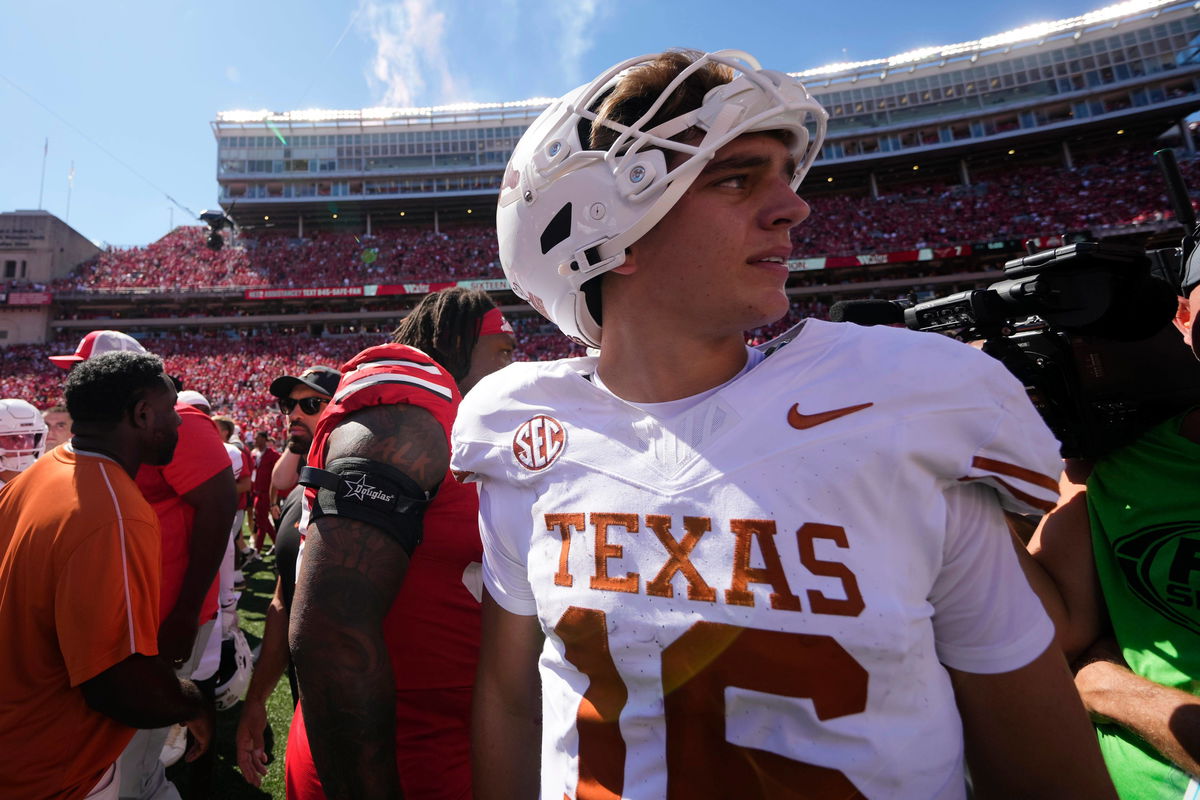
Imago
Arch Manning finally answered his critics with an outstanding performance against Sam Houston. The QB will be looking to extend his form.

Imago
Arch Manning finally answered his critics with an outstanding performance against Sam Houston. The QB will be looking to extend his form.
Texas beat UTEP 27–10, but the offense never found a clean rhythm, and Arch Manning’s timing told the story. Through three games, he’s 47-of-85 (55.3%) for 579 yards at 6.8 yards per attempt with six touchdowns and three interceptions. That is a notable dip from last year’s 67.8% and 10.4 YPA in limited action. The signs are easy to spot: the ball was held a beat longer, reads turned into late throws, and drives sputtered when on-schedule completions were there. The release that once snapped now lagged. Even with a 128.8 passer rating and 112 rushing yards on the season, the operation has felt more labored than lethal.
Watch What’s Trending Now!
Three interceptions in three games fit the normal learning curve for a new starter, especially after opening on the road against Ohio State’s defense. The difference is the spotlight. The Manning last name magnifies every wobble and compresses patience around the position. The peaks are real, like Manning’s 83‑yard strike against San Jose State, but so are the lulls that keep possessions behind the sticks.
On See Ball Get Ball, co-host Brent Rollins zeroed in on the hesitation that’s killing drives. He said, “Last year, his average time to throw… 2.74 seconds. Now, 3.25 seconds, which is the fifth longest in the power five… the indecisiveness, the ball is coming out… he holds on to the ball too long.” The number says what the film screams. He’s double-clutching routes that are there, and by the time he trusts it, they’re gone. For context, most top college passers live under three seconds on average, and many thrive closer to the 2.5–2.7 range, where rhythm, timing, and yards after catch flourish. When a quarterback creeps past three seconds consistently, sacks, hits, and bad-down football show up on schedule.
ADVERTISEMENT

Imago
NCAA, College League, USA Football: CFP National Playoff First Round-Clemson at Texas Dec 21, 2024 Austin, Texas, USA Texas Longhorns quarterback Arch Manning 16 prior to the game against the Clemson Tigers during the CFP National playoff first round at Darrell K Royal-Texas Memorial Stadium. Austin Darrell K Royal-Texas Memorial Stadium Texas USA, EDITORIAL USE ONLY PUBLICATIONxINxGERxSUIxAUTxONLY Copyright: xMarkxJ.xRebilasx 20241221_mjr_su5_011
David Pollack framed the rest, and it matters. The supporting cast isn’t what it was. “Last year, the weapons were better… They were more open. It was easier this year. It’s not as easy… The others have to make more plays, but he’s got to trust it… They got to get the running game going, too.” That’s the two-front problem. Texas has been banged up and young at the skill spots, with Tre Wisner sidelined, CJ Baxter limited, and DeAndre Moore in and out. Drops have stalled possessions. Timing with new faces has drifted. Still, the quarterback’s job is to be the thermostat, not the thermometer. The game should come from him, not at him.
So here comes Sam Houston, and it’s the last freebie for a while. This is where confidence gets rebuilt or doubts get cemented. Because after that, the schedule stops being polite. Florida will press and disguise. Oklahoma will squeeze windows and dare Arch Manning to be early with his eyes and decisive with his arm. And Texas A&M has looked surprisingly sharp, mean enough up front to expose any extra hitch. If Arch Manning trims that clock and takes the layups, Texas can breathe again. If not, the boos get louder, and the SEC gets very real, very fast.
ADVERTISEMENT
Arch Manning’s early struggles
The early-season buzz around Arch Manning has turned to unease and boos as Texas slogged through a win over UTEP while the passing game misfired. He finished 11-of-25 for 114 yards with one touchdown and one interception, and a midgame spiral included 10 straight incompletions that fed the frustration inside DKR. The numbers through three games tell a story of stop‑start rhythm rather than sustained command. The concern is the timing, conviction, and getting back to schedule that keeps drives on track.
ADVERTISEMENT
Afterward, Arch Manning didn’t duck the moment: “I’ve got to play better… I know I’m better than this,” he said, acknowledging the standard that comes with the name and the role. “All my life I’ve been an accurate passer,” he added. “I’ve just got to get back to it,” framing the slump as fixable execution, not a crisis of ability. Even as a preseason Heisman headliner, the reality is a 55.3% completion rate and a 128.8 passer rating show more grind than groove as Texas searches for rhythm. Owning the misses is step one, and tightening the clock and trusting the first window is step two.
Steve Sarkisian matched candor with faith, noting Arch Manning “pressed,” “missed some throws,” then “started skipping reads and depending too much on his legs,” cautioning that athletic plays alone “will catch up with you” if they pull the offense off script. At halftime, he even quipped that a quarterback hasn’t truly “experienced” the job until he gets booed, a rite that came during that second‑quarter rut before Texas leaned on defense and the run game to close it out. The legs did help; Manning logged 9 carries for 51 yards and two scores, but the fix now is timing and trust from the pocket before SEC defenses raise the degree of difficulty.
Top Stories
NFL Make Final Punishment Decision on Controversial Patrick Mahomes Incident

Horrific Aerial Footage of Greg Biffle’s Fatal Crash Emerges Leaving NASCAR Community in Tears

Tom Brady Hints at Nefarious Actions From Bears After Packers Lose Sideline Heaters

Another Almost Fatal Disaster Surfaces From Statesville Airport Amidst Ongoing Greg Biffle’s Crash Investigation

Johnson Wagner Admits Guilt for Making Jordan Spieth Miss Out on Rare PGA Tour Record

Olympic Champion Dominique Dawes Confirms Heartbreaking Outcome in Missing Family Member Search

ADVERTISEMENT
ADVERTISEMENT
ADVERTISEMENT

